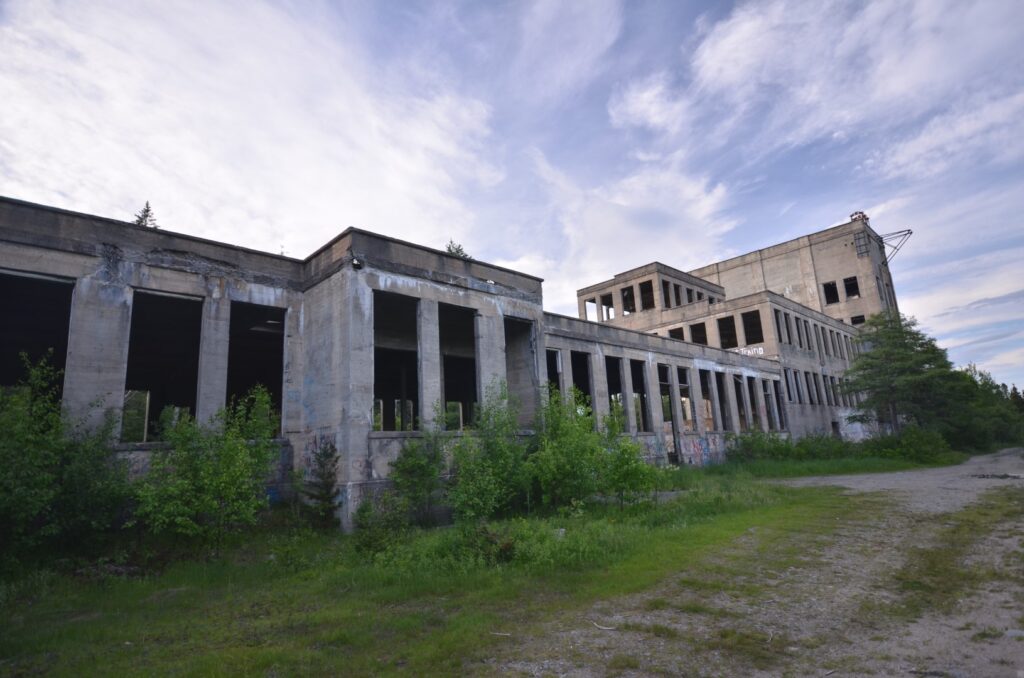More commonly referred to as the Glovertown Pulp Mill, this enormous concrete structure rises above the tree line in the small community of Glovertown. It was built in 1921 by the Terra Nova Sulphite Company but after processing just one shipment of logs, financial trouble with its Norwegian investors forced the mill to shutdown. Since then, its equipment and components have been removed leaving behind just an empty concrete shell still towering over the banks of the Terra Nova River.
The Story
During the early 20th century pulp mills became very popular as the demand for pulp was high. The island had an abundance in black spruce trees which were considered ideal for pulp and paper making. This led to the Terra Nova Sulphite Company to begin looking for investors for placing a pulp mill in Angle Brook (later amalgamated into the community of Glovertown). A location was soon chosen along the Terra Nova River which would allow for the production of hydroelectricity, allow easy transportation of logs from upstream, and allow easy shipping via the nearby port in Glovertown.
In early 1921, the Newfoundland Government granted the company timber rights for the area around the Terra Nova River and the rights for a hydro plant which was to be built along side the mill. First construction began on Angle Brook Island, with an expected opening date in mid 1922. During construction, piers were laid for the wharves in Angle Brook, and with a high expectation for success, schools, houses, and a medical centre were set up nearby to service workers at the mill. However, later that Fall construction was halted on the mill due to financial problems with the mills Norwegian investors caused by the falling Norwegian Krone (local currency). The mills owners brought the problem to the Newfoundland Government in hopes of being granted a loan to complete the mill, but it was quickly refused because of uncertainty with the viability of the project and the reliability of its investors.
The next year, in 1923 the Anglo-Newfoundland Development Company (AND Co.) purchased the partially completed mill along with its timber and hydro rights for approximately two million dollars. The company then sent 1300 cords of wood to the mill in order to test its equipment and facilities. After the test it was determined the mill was too small and inefficient and its power source (the Terra Nova River) was to unpredictable to produce reliable power.
Many locals protested and submitted complaints at the decision because of the employment benefits that were promised by the previous company and Government of Newfoundland. Letters and petitions were sent to both AND Co. and the government, but it was not enough to save the mill. The machines and equipment located inside the mill were then dismantled and shipped to mills in Bishops Falls and Grand Falls.

About the Area
Today the approximately 35-meter tall, 400-meter-long building towers over the treetops at the end of Angle Brook Road in Glovertown. When the mill closed it was not worth the money to demolish and because the outer structure was constructed entirely of concrete it continues to stand one hundred years later. Many signs in and around the building warn of falling debris and although it’s in better shape than many abandoned places, the height of the building make falling debris much more of a hazard. In 2020, increasing concern for visitor safety forced the town to install a fence around the perimeter to remind people the danger the structure poses. But as part of this it was also announced that the town would begin looking into ways to preserve the buildings history including upgrading local walking trails and installing informative signs telling the mills story.
Along the Terra Nova River nearby, the remains of part of the mills dam can be seen. While this has deteriorated significantly quicker than the mill, it continues to partially redirect water. Along the banks of the river near the mill, sinkholes and a narrow ditch mark the location of water intakes for the mill.
Sources
Higgins, J. (2007). Land-Based Industries of the Early 1900s. Newfoundland and Labrador Heritage Web Site. Found at https://www.heritage.nf.ca/articles/economy/landbased-industries.php.
Major, K. ( 1983). Terra Nova National Park: Human history study. National Historic Parks and Sites Branch, Parks Canada, Environment Canada. Retrieved from Memorial University of Newfoundland and Labrador’s Library.
Mercer, N. (2020, June 7). Newfoundland’s abandoned structures could be tourism magnets for many towns. Saltwire Network, The Chronicle Herald. Found at https://www.saltwire.com/nova-scotia/business/newfoundlands-abandoned-structures-could-be-tourism-magnets-for-many-towns-459204/.
Smallwood, J. R., & Pitt, R. D. W. (1981). Encyclopedia of Newfoundland and Labrador. St. John’s, N.L.: Newfoundland Book Publishers. (Article: “Glovertown”. Available online through the Centre for Newfoundland Studies collections database)